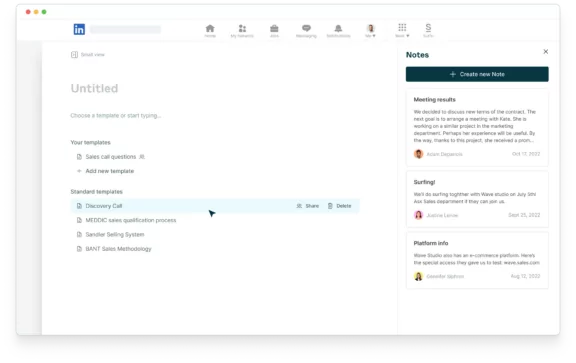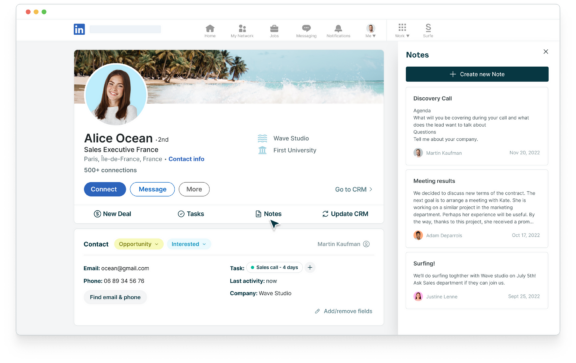5 Tips to get the best out of your sales notes

So you’ve been riding the sales wave for a while, you’re always on the lookout for new ways to boost your performance, and you’re wondering how you can improve your sales notes to close more deals. Well, you’re in luck, because we’re diving deep into the art of taking killer sales notes. Notes can be your secret weapon to success, helping you close more deals, understand your customers better, and surf through the competitive waters of sales with finesse. So grab your board and let’s paddle into the world of effective note-taking!
1. Wax up: Prepare your sales notes like you would your surfboard
It’s mega important to understand that sales notes as a concept is not just scribbling down random details, soundbites, and quotes during a sales call. Ensuring you have useful sales notes starts way before that.
When it comes to taking notes, it’s all about capturing the right information to guide your sales journey. Your notes should be concise, yet comprehensive enough to jog your memory when needed. So, how can you make the most out of your sales notes?
Before you even join the call you can add context to your call notes that will make everything much clearer when you need to do that all important referral back to them. The context of the conversation can include the date, time, location, and any relevant personal information. These seemingly small details can make a huge difference in creating personalized experiences and forging stronger relationships.
Then, focus on the key points that matter. There’s no point in taking notes if when you come off the call you don’t have the info you need. So make it your mission to capture these vitals:
- the prospect’s pain points,
- objections,
- desired outcomes,
- and any specific requirements they may have expressed.
This is like your North, South, East, and West. These notes will serve as your compass, helping you navigate the sales process smoothly.
Now when taking these, you’ve got to keep it organized so develop a consistent structure. The best approach is to use a standardized template that covers essential sections. Nail this and you will have nailed how to organize notes. Like this, you’re not going to forget any essential questions and you’ll know exactly where to type that vital insight as the prospect gives it to you. Having a structured approach like this and using templates is also going to make it easier to review and extract valuable insights from your notes after the call.
Saving time also means saving money and this can be key when the hard times come to ensuring that you are well-prepared to sell during a recession.

2. Hang Ten: Know What to Take Call Notes About
While it’s essential to capture the essentials, it’s equally important to be strategic with your note-taking. As an expert salesperson, you’ve mastered the art of active listening, and your notes should reflect that.
Instead of writing down every single word, focus on key insights we already discussed, pain points, objections, and opportunities. By distilling the conversation into actionable nuggets, you’ll save time during follow-ups and ensure your efforts are focused on what matters most. There’s no deal killer like having to ask the same questions again and again because you didn’t note it down the first time. “Sorry, what tool did you say you wanted to integrate with?” Your prospect will lose patience and feel like you’re not listening to them.
One valuable tip is to use a combination of shorthand, symbols, and bullet points to make your notes concise and easy to review. This way, you’ll have a shorthand language that only you understand, streamlining the process and keeping your notes organized.
As the sales process progresses, document objections and questions raised by the prospect. By noting these down, you can better address them in future interactions, building trust and credibility along the way.
Additionally, be sure to highlight any commitments or action items that arise during the conversation. This will help you stay on track and ensure that nothing slips through the cracks. If they mention something they want to see by the next call, don’t forget to take note so you can make sure you have it in time for them.
Likewise, maybe they have some commitments that it’s important to consider. This doesn’t even necessarily have to be about your solution either. Maybe they mention an upcoming personal commitment that is taking up a lot of their time. “Yeah, I’m rushing to get everything done this week because I’m off on Friday to go to a wedding.” On the next call, ask them how the wedding was. Show them you care about everything they are telling you. And then you can even slip in a comment about how your solution is going to save them time leading up to the next busy weekend they have planned.
3. Don’t hog the set: Sharing is caring.
In the world of sales, it’s important to remember that you’re not riding the waves alone. The value of your notes increases by orders of magnitude when they’re shared with a team. If you work in a collaborative environment, making notes becomes a game changer when you come across a prospects profile on LinkedIn or a contact in your CRM and see that a colleague has already added a bunch of context. It can save so much time and ensure you don’t cross paths and scare off a prospect by looking unorganized.
During team meetings or internal discussions, leverage your notes to share valuable insights with your colleagues. By collaborating and pooling your knowledge, you can uncover new strategies, refine your sales process, and boost overall team performance.
Sharing your notes with the right people can amplify your success and create a sense of camaraderie. So, who should you be sharing your notes with?
- Sales Teammates: Your fellow sales warriors are your allies in the battle for success. Sharing your notes with them fosters collaboration and allows you to learn from each other’s experiences. Discussing your notes during team meetings or through collaborative platforms can lead to valuable insights, brainstorming sessions, and ultimately, stronger sales strategies.
- Managers and Mentors: Your sales managers and mentors are seasoned surfers who have ridden many waves before you. They can provide guidance, offer constructive feedback, and help you fine-tune your sales approach. Sharing your notes with them opens up opportunities for coaching and mentorship, allowing you to refine your skills and grow as a sales professional.
- Support and Customer Success Teams: Riding the sales wave isn’t just about closing deals; it’s also about ensuring customer satisfaction and retention. Sharing your notes with the support and customer success teams keeps them in the loop regarding customer expectations, pain points, and goals. This collaboration enables them to provide superior post-sale support and maintain strong relationships with customers.
Remember, sharing your notes isn’t just about giving; it’s also about receiving. Be open to receiving feedback and insights from your peers, managers, and other teams. Embrace the spirit of collaboration and mutual support within your organization’s sales ecosystem.
4. Leverage technology: Sales Note-Taking Tools
To truly propel your note-taking with maximum efficiency, it’s essential to equip yourself with the right tools. It’s 2023 and we hate to be the ones to say it but a pen and paper just isn’t enough to be the best anymore. It’s a simple fact: integrating digital tools is a key pillar in a guide of sales success and motivation.
Here are a few options that can help you level up your note-taking game:
- CRM Systems: Customer relationship management (CRM) systems are powerful tools that enable you to centralize customer data and streamline your sales process. Many CRMs, such as Salesforce, HubSpot, or Pipedrive, include note-taking capabilities. By leveraging these features, you can link notes to specific leads or opportunities, track interactions, and gain a holistic view of your sales pipeline. Another benefit of this is that since it’s in a CRM that your team work collaboratively on, your team can quickly see any notes you have made on a specific contact or company.
- Integration Tools: Surfing through the sales process involves using various tools and platforms. Look for integration options that allow your note-taking tools to seamlessly connect with other sales tools you use, such as email clients, calendars, or project management platforms. These integrations can enhance your workflow and ensure that your notes are always in sync with your sales activities.If you’re doing your prospecting on LinkedIn, Surfe has a great note taking feature that is going to save you so much time you’ll be kicking yourself for not having found out about it earlier. Surfe connects LinkedIn to your CRM so that you can add people to your CRM directly from LinkedIn. Combined with Surfe’s note taking feature, you can easily see the notes you’ve made on specific clients when browsing LinkedIn. Surfe users that really take their sales notes to the next level use Surfe’s note template feature. Remember the templates we were talking about at the start of this article? Create one in Surfe and have it ready to go for every single sales call. Just go straight to your prospects LinkedIn profile and add call notes as you go along – your template will be there waiting for you every time.

3. Digital Note-Taking Apps: Embrace the convenience and flexibility of digital note-taking. Apps like Evernote, OneNote, or Google Keep allow you to organize, search, and access your notes from anywhere. They also offer features like tagging, reminders, and synchronization across devices, making it easy to stay organized and up-to-date.
4. Voice Recording Apps: Sometimes, the best insights come when you’re in the midst of a conversation. Voice recording apps like Otter or Rev can capture your sales calls or meetings, providing an accurate transcript of the conversation. These transcriptions can be invaluable for reviewing important details or referencing specific discussions later on.
Experiment with different note-taking techniques and tools to find the tools that work best for you and incorporate them into your routine.
Congratulations! You’ve learned some gnarly tips on how to maximize the potential of your sales notes and should now be able to level up your quality of sales. Remember, effective note-taking is about capturing the right information, using it strategically, and collaborating with your team.
As you cruise through the calls, fine-tune your note-taking skills, experiment with different tools, and maintain an open mindset for continuous improvement. Your notes will become your trusted allies, helping you navigate the twists and turns of the sales journey with confidence and finesse.
So, grab your board, paddle out, and ride the big wave of success with the power of well-crafted, strategic sales notes. It’s time to make every interaction count, exceed your goals, and become the true legends of the sales world!

Save your sales notes as templates
Take notes on your prospects, deals, and calls straight from any website or LinkedIn. Surfe will automatically sync them with your CRM so they don’t get lost.


